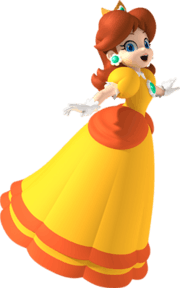Princess Daisy
| Princess Daisy | |
|---|---|
| Mario character | |
 Princess Daisy as she appears in Mario Party 8. | |
| First appearance | Super Mario Land (1989) |
| First game | "Super Mario Land" (1989) |
| Created by | Gunpei Yokoi |
| Voiced by |
Jessica Chisum (Mario Tennis) Jen Taylor (Mario Party 3–5) Deanna Mustard (since Mario Golf: Toadstool Tour in 2003) Noriko Hidaka (Japanese DVD dub of Super Mario Bros film) Maya Okamoto (Japanese Nippon TV dub of Super Mario Bros Film) |
| Portrayed by | Samantha Mathis (Super Mario Bros.) |
Princess Daisy (Japanese: デイジー姫 Hepburn: Deijī-hime, pronounced [deː.dʑiː çi̥.me]) is a fictional character in the Mario series of video games, in which she is the princess of the fictional region of Sarasaland. She first appeared in Super Mario Land as the game's damsel in distress, a role usually reserved for Princess Peach. Since her appearance in Mario Tennis, she has become a staple playable character in the Mario spin-off games, in which she is often paired up with Peach. It is often speculated that she is Luigi's love interest.[1][2] Her official description for Mario Party 4 states that she and Luigi have a rumored love interest, more so from Luigi; but Waluigi likes her too, which she does not appreciate.[3] Despite this, Daisy and Luigi have never been seen to interact in a romantic manner in the games. Daisy appears as a protagonist in the 1993 film Super Mario Bros., portrayed by Samantha Mathis.
Concept and creation

Super Mario Land's producer, Gunpei Yokoi, wanted to recreate the feeling of 1985's Super Mario Bros., only set in a separate world to the Mushroom Kingdom.[4] This world would be Sarasaland (sometimes styled Sarasa Land), and Daisy would be its princess. However, later games mention that she now resides in the Mushroom Kingdom,[5] and Sarasaland is only hinted in Daisy's quotes and biographies for subsequent games. Her early design looked more similar to Princess Peach, except with orange-brown, titian hair instead of yellow hair, a yellow gown with short puffy sleeves, white frills, orange high heels, a daisy-shaped brooch, crown and earrings, and wrist-length white evening gloves. In 2000's Mario Tennis, she appeared in game artwork with long hair like Pauline, and retained her flower brooch and earrings. She also had a slightly darker skin tone. This design endured until 2002's Mario Party 4, in which she was given her current design which distinguished Daisy further from Peach by depicting her with different physical traits, such as a flip hairstyle and light skin, yet with her gown design and crown color being more consistent with Peach's. In her first appearance, Daisy was described as a tomboy,[6] a trait which has maintained throughout the games, with Daisy being depicted as a more cheerful and boastful character than Peach. In Mario sports games, she wears more athletic outfits instead of her usual gown, her color scheme normally being yellow and orange. Her special abilities are often based around flowers, with the daisy flower being her namesake.
Appearances
In video games
As of 2018, Daisy has appeared in 59 games, in most of which she is a playable character. Her first appearance in the Mario series is in Super Mario Land, released in 1989 for the Game Boy. Daisy is the princess of Sarasaland, a world outside of the series' usual setting of the Mushroom Kingdom, who is kidnapped by the tyrannical alien, Tatanga,[7] who intends to marry her in order to gain control of her realm. Mario must traverse the four kingdoms of Sarasaland in order to track down Tatanga and rescue Daisy. She next made a small appearance in NES Open Tournament Golf in 1991 as Luigi's caddy. She did not appear in another game for nine years until 2000's Mario Tennis by Camelot Software Planning on the Nintendo 64, in order to introduce more human characters into the game.[8] Daisy is regularly a playable character in the Mario sports games. She appears in all of the Mario Party series since Mario Party 3 except Mario Party Advance, and all of the Mario Kart games since Double Dash except for the first two installments of the Arcade GP series, and all five games in Mario & Sonic at the Olympic Games. She also appears in the Square Enix game Fortune Street. On September 29, 2017, Daisy was added to the list of playable characters in Super Mario Run.[9]
Outside of the Mario game series, Princess Daisy was included as a skin in the Minecraft: Wii U Edition Super Mario Mashup Pack, released on May 16, 2016.[10] Additionally, Daisy has been alluded in various games. For example, in every Super Smash Bros. title released since Super Smash Bros. Melee, in addition to Daisy's appearance as trophies, one of Peach's reoccurring alternate skins represents Daisy's color scheme. In the Wii U and Nintendo Switch versions of Bayonetta and Bayonetta 2, one of Bayonetta's Nintendo outfits is based on Daisy's dress design.
Daisy's amiibo was released on November 4, 2016 to coincide with the release of Mario Party: Star Rush.
On June 12, 2018 at E3 2018, she was introduced as a newcomer in Super Smash Bros. Ultimate, as Princess Peach's "echo fighter" (a character whose moveset and physics are similar to another character's).
In other media
Daisy was one of the main characters of 1993's Super Mario Bros. film, loosely based on the games, in which she was portrayed by Samantha Mathis. In the film, Daisy is a student of archaeology at New York University whom Luigi falls in love with. While digging for dinosaur bones under the Brooklyn Bridge, Daisy is kidnapped by two henchmen of President Koopa, the dictator of an alternate world in which dinosaurs rule, of which Daisy is actually the princess. Due to the larger role she plays in the movie, it is speculated that her role was merged with Princess Peach's. Luigi and Mario give chase in order to rescue her. Daisy also appeared once again as the prisoner of Tatanga in some episodes of the Nintendo Comics System.
Reception
Initially, Princess Daisy drew little comment. In her early appearances, she was so similar to Princess Peach that some journalists even assumed that "Princess Daisy" was simply a new localization of "Princess Peach" rather than a new character.[11]
GameDaily listed Daisy at number eight in a top-ten list of Mario characters who deserve their own game.[12] GamerVision's "Coop" wrote an article entitled "Top Ten Reasons Daisy is Better Than Peach", giving reasons ranging from her having a "less-annoying voice" and having a "better attitude", to Daisy being a better ruler due to the fact that Sarasaland has only been invaded once, whilst Peach's Mushroom Kingdom is always being invaded.[13] Destructoid's Gamer's Red Carpet called "her choice of a brave yellow and orange combo dress... as flattering as it is retro", and that her dress and accessories "work much better than Peach's", grading her a B+ overall.[14]
In 2010, Audrey Drake at IGN listed Daisy as a potential valentine for Mario, commenting that being his "brother's gal" made her a sort of "forbidden fruit", and that he had saved her during the events of Super Mario Land.[15] GamesRadar's Henry Gilbert wrote that it became increasingly evident that Luigi also needs "his own princess" and Princess Daisy is the character he is closest to.[1] The pairing of Daisy and Luigi was included in Screw Attack's "Best EVER: Love Stories" video. She was also featured on Susanna Sheath's top 10 Mario characters as her number two choice.[16]
IGN reviewed Daisy negatively, giving her a 4 out of 10, whereas Princess Peach got an 8, Rosalina a 7 and Pauline an 8, but said that the "spark between Daisy and Luigi still burns bright."[2] Lisa Foiles of The Escapist ranked Daisy number one on their list of top five annoying princesses in video games, stating she didn't really have a good reason why.[17] Daisy's infant counterpart, Baby Daisy, was listed by 1UP.com as one of the worst Mario Kart Wii characters.[18]
References
- 1 2 Gilbert, Henry. "Page 3 – Luigi: A life in the shadows". GamesRadar. Archived from the original on 4 March 2016. Retrieved 25 September 2016.
- 1 2 Pirrello, Phil. "Mario's Ladies: The Princesses of Mario Galaxy". IGN. Retrieved 25 September 2016.
- ↑ Hudson Soft. Mario Party 4. Nintendo.
Daisy is a feisty girl who loves to get dirty and play with the rest of the crowd. Luigi has quite a crush on her, and it's rumored there is an attraction between the two. Waluigi also happens to have a crush on Princess Daisy, which she does not approve...
- ↑ Fahs, Travis. "IGN Presents The History of Game Boy". IGN. Retrieved 2012-05-12.
- ↑ Hudson Soft. Mario Party 6. Nintendo.
Peach missed female companionship until this girl with the orange hair moved into the Mushroom Kingdom.
- ↑ "Characters". Nintendo Japan. Retrieved September 25, 2016.
- ↑ Stars. "Princess Daisy". IGN. Retrieved 25 September 2016.
- ↑ "Mario Tennis Website". Nintendo. Retrieved 25 September 2016.
- ↑ "Nintendo is updating Super Mario Run with a new character, mode, and world". The Verge. Retrieved 2017-12-04.
- ↑ GameXplain (2016-05-18), All 40 Mario Skins in Minecraft Wii U Edition (Koopalings, Rosalina, Daisy, Toadette, etc), retrieved 2016-06-10
- ↑ "Super Mario RPG". Next Generation (12): 139–140. December 1995.
Princess Peach (or Daisy as she was renamed in the West) ...
- ↑ "Top 10 Nintendo Characters That Deserve Their Own Games". GameDaily (via Internet Archive Wayback Machine). Archived from the original on October 19, 2008. Retrieved 25 September 2016.
- ↑ Coop. "Top Ten Reasons Daisy is Better than Peach". GamerVision. Archived from the original on 7 April 2010. Retrieved 25 September 2016.
- ↑ Concelmo, Chad (May 13, 2010). "The Gamer's Red Carpet: Super Mario Bros". Destructoid. Retrieved July 31, 2013.
- ↑ Drake, Audrey. "Who Should Be Mario's Valentine?". IGN. Retrieved 25 September 2016.
- ↑ "The Best EVER: Love Story". Screw Attack. Archived from the original on 15 February 2012. Retrieved 25 September 2016.
- ↑ Lisa Foiles. "Top 5 Annoying Princesses | The Escapist". Escapistmagazine.com. Retrieved 2014-06-19.
- ↑ Bettenhausen, Shane. "Mario Kart Wii Review". 1up.com. Archived from the original on 4 November 2016. Retrieved 25 September 2016.

